Discover how to leverage modern Unix even if you’ve never worked with Unix before. This book presents everything in conceptual terms that you can understand, rather than tips to be committed raw to memory.
You will learn everyday tasks ranging from basic system administration—partitioning and mounting filesystems, software installation, network configuration, working from the command line) — to Bourne shell scripting, using graphical applications, as well as fanciful things such as emulation layers for Windows and Linux and virtualization with Virtual Box.
It’s now 50 years since the creation of Unix but it is still growing. As Unix now moves to everyone’s OS (open-source Free BSD/Linux), it is the perfect time to start your journey with Beginning Modern Unix as your guide.
What You’ll Learn
- Live comfortably in a modern Unix environment, both on the command-line and in the graphical world.
- Choose the right hardware for Unix
- Work with Unix in real world settings
- Develop Unix applications
- Review advanced techniques in Shell scripting
Who This Book Is For
Everyone who uses a computer – those who intend to migrate to Unix as well as those who are worried about migrating to Unix, perhaps fearing it is a pure command-line or ‘difficult’ world.
Tabella dei contenuti
Part 1: What Can You Do With Unix Emulation.- 1. Editing Text With Vim and Joe.- 2. Essential Unix Commands and Terminology.- 3. Bourne Shell Scripting.- Part 2: The World of Real Unix.- 4. PC Hardware for Unix.- 5. Installing and Configuring Free BSD/Linux.- 6. Basic System Administration.- 7. The Best of the Graphical Unix World.- 8. Emulation Layers: Wine and Linuxulator.- 9. Virtualization: The New Buzz Word.- Part 3: Developing Applications Under Unix.- 10. Advanced Techniques in Shell Scripting.- 11. Unix Programming with C and Vala.- Appendix.
Circa l’autore
Manish Jain has worked with Unix for over 15 years, and has worked for companies such as IBM, Pitney Bowes, and Cognizant. In 2011, he received the Cognizant Alliance Award (Cognizant’s highest award for programmers) for revamping Pay Pal’s monolithic Risk Management code for failed Bank transactions to create a static library with gains in scalability and performance. This involved ~10, 000 lines of code delivered in C++ (Red Hat Linux).












